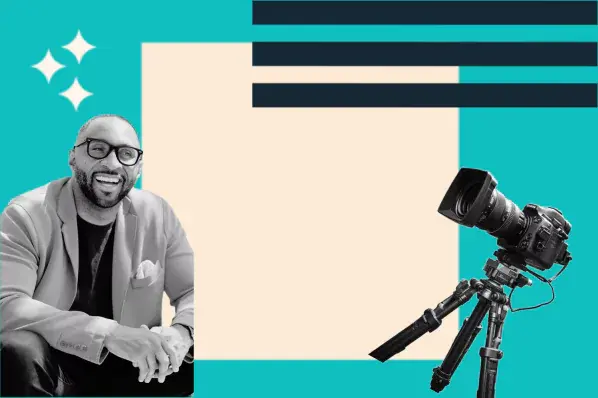Salespeople often talk about using video, but most of them are afraid of it. Video can help you stand out from the crowd and differentiate yourself from other sellers — but it can be intimidating in the beginning. I mean, it's uncomfortable enough talking into a camera lens by yourself, much less knowing people will watch the video and judge your ability to talk to the lens.
No need to worry, though. This blog will explain how to use video to schedule and close meetings.
Table of Contents
- Video Selling Basics
- Why Use Video?
- Introduction to Video Prospecting
- Using Video for Follow-up After a Meeting
- Objection Handling With Video
- The Proposal Video
- Asking for a Referral With Video
Video Selling Basics
When you want to make a video, you must start with the basics.
Here are the steps that you need to follow:
1. Look into the Camera: Looking at yourself while recording can make you nervous. I encourage everyone I work with to look directly into the camera to make it feel like they are speaking to a real person. Establish direct eye contact to create a personal connection.
2. Good Lighting: The goal here is to avoid looking like you're in a cave. No one wants to talk to someone who looks like they are in the dark. Ensure your face is well-lit so you shine bright on the camera and come across clearly.
3. Background: Sometimes, I throw my hoodie on the couch behind me (it happens from time to time), but you want to be sure to keep a professional appearance and clean up your background — ensure you don't have dirty laundry making a guest appearance. Keep your background clean and professional. Show up how you want to be remembered.
4. Good Camera: This can be a game changer, but it’s not required to get started. Lighting is the most important thing here, but having a good camera doesn't hurt. A Logitech camera is a great start to ensure the quality comes through and you have a clear video.
5. Stand Up: I know you are thinking about Ludacris when you see this, but that isn‘t what I am talking about. We’re talking about standing up when you make the video because it will enhance your energy, confidence, and focus. Standing up makes all the difference with the reps I work with.
6. Dress to Mirror Your Audience: The best way to know what to wear is to match your audience. For example, in the finance space, it's probably best to wear a suit and tie. Know your audience to know what to wear.

HubSpot's 2025 Sales Trends Report
This in-depth report includes sections, covering:
- How buyers are becoming more self-informed
- How sales teams are using AI and automation
- Adapting to tighter budgets
- And more!
Download Free
All fields are required.

Why Use Video?
It's the best way to create a personal touch without meeting someone in person. As I mentioned at the beginning of this article, many hesitate to use video because they fear it.
- They don’t know what to say.
- They're worried about being ridiculed.
- They don't like the way they sound and look.
These are all normal feelings. I felt the same exact way. Pretty sure I was shaking in my first video. However, once you follow these steps you will walk away feeling excited to use video and enjoy it. With HubSpot's Clip Creator, creating engaging videos in just a few minutes is easy — making it perfect for beginners. Ultimately, video is about building trust at scale and making the buyer more engaged throughout the sales process.
Introduction to Video Prospecting
Video prospecting is like creating a movie trailer. My research found that the best trailers are 60 to 90 seconds long, so I reduced that range to 50 seconds for a prospecting video. If you dig deeper into the trailer‘s purpose, it’s designed to capture attention and entice viewers to watch the movie.
Similarly, you want to pattern interrupt our future clients so they are willing to accept a meeting.
You're selling the meeting, not the solution.
Here's a framework for creating a great prospecting video.
Framework: 10-30-10
- 10 seconds: Reason for my video.
- 30 seconds: Value proposition / unique selling point.
- 10 seconds: Call to action (CTA).
Reason for My Video:
Start your videos with confidence and clarity. An example might be, “Hi Tony, the reason for my video is…”
Make sure after the reason you bring up a clue or compelling insight you found on the website. You want to ensure this stands out to the person watching the video. Here is an example of that:
Product Update: “I noticed you had a product update. Typically, this means you’re looking at new messaging. How we approach this is…”
Value Proposition/Unique Selling Point.
What are you offering them that will help them in their specific scenario or that solves a pain point for them?
Here's an example — "Our coaching services empower your sales rep to leverage our video frameworks to book more meetings."
Call to Action (CTA)
You need to tell people exactly what you want from them.
I like Interest CTAs like:
• “Would you be interested in learning more?”
• “Would you say this aligns with your top initiatives?”
• “Are you curious to have a deeper dialogue on this topic?”
These frictionless CTAs typically open the prospect to respond and lead to more meetings.
Your video should be about 45-50 seconds long. As you get better at this, you want to aim for 35 seconds long.
Two Types of Prospecting Videos:
You can send two types of prospecting videos.
1. Standalone Videos
The Standalone video is often used for services. It's like a personalized YouTube video where you talk directly to the viewer. This approach is excellent for selling services since you are selling yourself. However, it works well for selling products too, especially to marketers or sales leaders, but it can work with other audiences as well.
Based on my experience, these are my favorite videos because they showcase your personality and allow for a human connection without being in person.
The key here is to maintain pacing in this video so you don't sound like a wild content creator. Have confidence in your approach based on your research, and keep eye contact with the camera while speaking.
2. Screenshare Videos
When you think about your screen-share prospecting videos, treat them like mini demos.
These should last 45-60 seconds where you share your screen and navigate to a relevant website or product page
- Highlight a key feature of your product
- Share a recent update that you found
- Walk through your website to talk about a compelling insight
Be sure to show your research as you talk through the video.
Here is an example script you can steal from me on how to start:
Product Update: “I’m on Bobby’s site; you have a product update. We help you coach your messaging. Here is why…”Using Video for Follow-up After a Meeting
Effective follow-up with video can significantly boost your engagement. Here’s how to structure your follow-up videos.
You use two different follow-up strategies after you finish our discovery call.
1. Long video follow-up with all parties involved
2. Short video follow-up to a specific person
Long-Form
The purpose of the long video follow-up is to recap what happened in the meeting. Please do not try to sell them hard in this video.
Focus on their most specific goals, timeline, and the next steps. This is the framework you want to focus on every single time. Occasionally, you might include additional details like use cases if they're relevant, but these core elements are what you constantly need to cover.
Short-Form
My preferred method for the short video follow-up is sending a 10 to 15-second video via LinkedIn. You can use Slack or Text here as well, but LinkedIn is easier because you can connect with someone and send this immediately after.
My framework here is I thank the person for joining the call and offer to address any direct questions they might have had but didn't feel comfortable asking in a group setting. This approach is successful because people are way more comfortable sharing in a one-on-one setting rather than in a group.
Objection Handling With Video
Handling Objections with Video
Handling your objections with confidence is the key to overcoming them. That is why I suggest video to handle objections is the best way to convert.
Videos allow you to showcase your personality, tone, and confidence
Here's a structured approach:
1. Acknowledge the objection.
2. Ask a clarifying question to ensure you understand their concern.
3. Address the objection confidently and thoroughly.
4. Provide a clear call to action, inviting feedback or further discussion.Also, take your response to the converted email and use that as your script.
These videos will be longer than your prospecting videos, but it's ok because you have already developed a relationship with the client.
The Proposal Video
This is my favorite way to use video and I wish more people would do it.
Using a screen share video for proposals adds a personal touch and context to your proposal.
Remember your proposal isn‘t for the people you have spoken to, it’s for those you haven't spoken to.
Here's a structured approach for a video walkthrough:
1. Acknowledge the influencer or champion who provided insights.
2. Describe the current state of the client's situation.
3. Explain how your solution will move them to the future state.
4. Highlight relevant use cases to demonstrate success.
5. Address pricing and investment, inviting any concerns or questions.This video is typically five to eight minutes long because you are going in-depth on your proposal. Sometimes it can be longer, but this is the ideal range I have seen.
This ends up being successful because it's easier for a decision-maker to watch an eight minute video instead of being in a 30-minute meeting. Plus, they can hear you break down complex points and add clarity to any questions that they have.
I highly recommend as a seller using this on every single proposal you can. Buyers tend to appreciate it.
Asking for a Referral With Video
Oh, you thought it was over after closing the deal? Guess again. After closing the deal, it's time for the next step that will lead to more meetings: the referral.
Now, most people are afraid of asking for a referral which is exactly why you will ask. This should be an easy ask as long as they have enjoyed your services and solution.
Let's break down this process.
Look at LinkedIn's mutual connections with the person you want to ask, and you can see which contacts you want to contact. Video makes this process more approachable and increases the likelihood of a positive response.
When you ask for the referral make sure to find two or three people to ask for so that you have options. Then before you send the video, always ask if they can do you a favor. Typically, they will say yes. Now when you send the video, they are way more likely to respond.
Now when you create the video follow these steps:
- Thank them for being willing to watch the intro.
- Mention the two or three people.
- Say at the end if those two or three people don‘t match or you don’t know them, who else that is like-minded like you should I speak to?
That will open up the doors for them to refer you to someone else if needed. These videos typically are 20 to 30 seconds.
This approach streamlines the referral process and helps in securing more meetings.
Using Video to Level up Your Sales Game
I touched on this at the start of this article, but I‘ll say it again: Leveraging video in sales can seem imposing. Getting on camera isn't always easy, and in some cases, it can feel a little unnatural — and it's perfectly fair to feel that way.
But as intimidating as it might seem, video can still be an invaluable resource for virtually any sales professional. It's one of the better ways to clearly convey key insight and frame a compelling value proposition with a personal touch.
So, what advice do I have for any salesperson who's interested in but reluctant about trying to up-level their sales efforts with video? Power through.
Follow the fundamentals I‘ve outlined here, and you’ll put yourself in a solid position to enhance virtually every aspect of your sales process — from prospecting all the way to asking for referrals.
Video in Sales


![Download Now: 2025 Sales Trends Report [New Data]](https://no-cache.hubspot.com/cta/default/53/9cdc68ed-d735-4161-8fea-0de2bab95cef.png)
